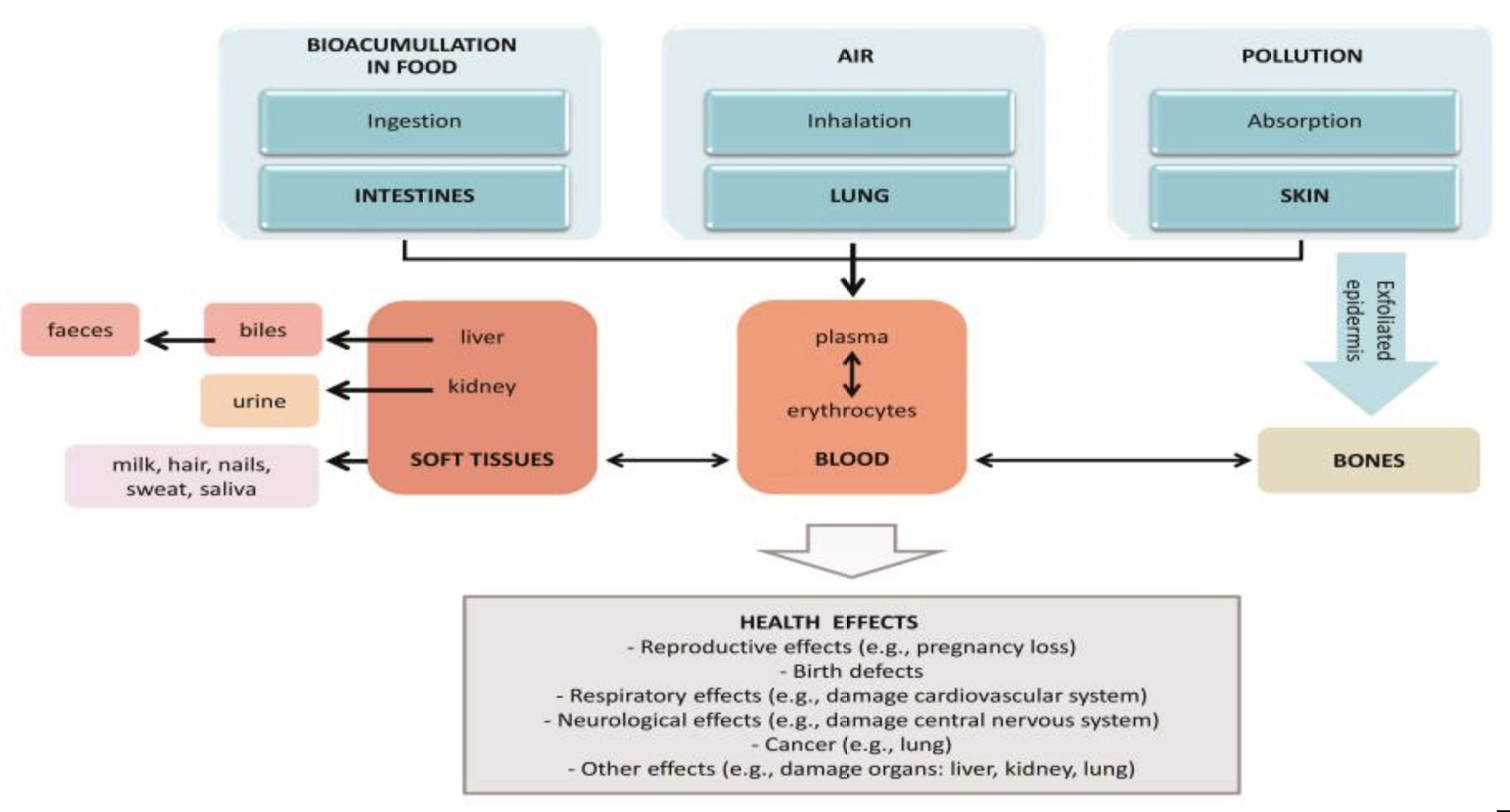Key takeaways:
~ Lead exposure increases oxidative stress, and lead can take the place of other ions in the cell.
~ At higher levels, lead is toxic for everyone, but that tipping point isn’t the same for everyone.
~ Genetic variants can increase your susceptibility to health problems from lead at lower levels.
How do your genes affect lead exposure?
Lead is a toxic heavy metal that can be found in various environmental sources. It can cause a number of adverse health effects, even at low levels of exposure.
Problems associated with lead exposure include:
Neurological effects:
Lead can damage the nervous system, especially in children, leading to learning difficulties, behavioral problems, and lowered IQ. In adults, lead exposure has been linked to memory loss, mood disorders, and peripheral neuropathy.[ref]
Hematological effects:
Red blood cells are formed in the bone marrow. Lead directly interferes with the production of red blood cells, leading to anemia. Genetic variants in the heme system increase the likelihood of hematologic effects at lower levels.[ref]
Cardiovascular effects:
Lead exposure has been associated with an increased risk of high blood pressure, coronary heart disease, and stroke in adults. However, studies on lead levels in adults do have conflicting results as far as how much of an effect lead has on blood pressure. What is clearer is that lead is also associated with longer QT intervals in some people with certain genetic variants.[ref][ref][ref]
Bone health:
Lead can accumulate in the bones and remain there for decades. During periods of increased bone turnover, such as pregnancy and menopause, lead can be released back into the bloodstream, causing further health problems. Additionally, lead directly reduces bone mineral density, in animal studies, and causes the formation of poor quality bones.[ref][ref]
Renal (kidney) effects:
A number of epidemiological studies show that chronic lead exposure can cause kidney damage and lead to chronic kidney disease.[ref]
Reproductive effects:
Lead can affect both the male and female reproductive systems, leading to reduced fertility, increased risk of miscarriage, and adverse pregnancy outcomes.[ref]
Mechanism of action:
So why is lead bad?
Lead interferes with and affects many different cellular pathways. Lead can replace other ions, including calcium, magnesium, iron, and sodium, which interfere with intracellular signaling, protein and enzyme formation, and apoptosis.[ref]
Lead can also replace zinc ions in certain proteins, which can cause the proteins to misfold. For example, a class of proteins called zinc finger proteins are important as transcription regulators and for RNA packaging, which means that lead replacing zinc can impact the transcription of a bunch of different genes.[ref]
Another particularly harmful aspect of lead in the body is that it can induce oxidative stress by decreasing a cell’s ability to produce antioxidants.[ref]
Children are most vulnerable to the effects of lead because their developing bodies absorb lead more readily, and their nervous systems are more sensitive to its toxic effects. Even low levels of lead exposure in children have been linked to reduced cognitive function, academic performance, and social or behavioral problems.
Sources of Lead Exposure:
Heavy metal contamination is prevalent in many areas of the world, and lead exposure can happen through multiple routes.
Here are some sources of lead in the environment:[ref]
- Sewage sludge, which is often used as a biosolids fertilizer, may contain higher concentrations of lead
- Leafy greens grown in lead-contaminated soils
- Glazed ceramic and crystal dishes and glasses can contain lead
- Working in industries such as battery manufacturing or paint removal (lead paint)
- Lead shot and lead fishing weights contribute to groundwater and soil lead contamination
- Target shooting, especially indoors[ref][ref]
Note that lead is no longer allowed in hair dyes, and the FDA claims that 99% of tested cosmetics are below the 10ppm limit on lead.[ref]
What about lead in foods?
The CDC recently issued a warning that certain brands of fruit puree marketed to children, such as cinnamon applesauce, are high in lead. There were multiple reports of children with lead toxicity from them. Here’s a list of what was recalled.
Lead is sometimes added to cinnamon to make it darker. For example, in March 2024, La Fiesta Foods cinnamon was recalled by the FDA due to lead contamination.[ref]
ConsumerLab.com, in testing psyllium fiber supplements, found that some contain up to the daily value of lead in one serving. For example, one type of Metamucil was right at the limit for lead, so taking more than a single serving would exceed the daily limit.[ref] I’m mentioning this specifically because a lot of people take a fiber supplement daily, and it was a surprising source of lead contamination.
ConsumerLab also tested cinnamon, seaweed, and green supplements for lead content. Of the cinnamon brands tested, the only product that didn’t pass was Badia Cinnamon Powder.[ref] Several seaweed snacks also tested above the Canadian and California Prop 65 limit for lead, as did Dr. Mercola Fermented Greens supplements and Zazzee Organics spirulina powder.[ref][ref] (Algae and chlorella take up heavy metals rapidly[ref])
Lead Absorption:
Lead can enter the body through various routes:
- Inhalation (industrial exposure such as battery manufacturing, target shooting, car exhaust in countries with leaded gas, dust from soil that contains lead)
- Ingestion (lead in water pipes, lead-based paint, lead contamination in cinnamon and other spices, lead in soil)
- Dermal absorption (dust, soil, cosmetics that contain lead, industrial workers, target shooting)
Once absorbed, lead is distributed throughout the body, primarily accumulating in the bones and teeth.
The absorption of lead is influenced by factors such as age, nutritional status, and genetic variations.
The problem of lead exposure is compounded by the fact that lead can persist in the environment for a long time, and the effects of lead toxicity may not be immediately apparent. This means that even if lead exposure is reduced or eliminated, the health consequences may continue to manifest for years to come.

Genes Influencing Lead Detoxification:
ALAD (δ-Aminolevulinic Acid Dehydratase):
ALAD is an enzyme involved in the heme biosynthesis pathway. Heme is an iron-containing compound that is part of hemoglobin, which is how blood is able to carry oxygen through the body.
Polymorphisms in the ALAD gene, particularly the ALAD-2 allele (see the genotype report below), have been associated with increased blood lead levels. The ALAD-2 allele is thought to enhance the binding of lead to the enzyme, reducing its activity and leading to higher blood lead concentrations.[ref]
GSTM1 and GSTT1 (Glutathione S-Transferases):
The GST enzymes involved in the detoxification of various xenobiotics, including lead. Null genotypes of GSTM1 and GSTT1, resulting from gene deletions, have been associated with higher blood lead levels. The absence of these enzymes may impair the body’s ability to eliminate lead efficiently.
HFE (Hemochromatosis Gene):
Lead uptake affects iron metabolism also. Mutations in the HFE gene, particularly the C282Y and H63D variants, have been linked to increased blood lead levels. These mutations are associated with hereditary hemochromatosis, a disorder characterized by excessive iron absorption. The relationship between HFE mutations and lead levels may be due to the shared absorption pathways of iron and lead in the body.[ref]
SLC11A2 (Solute Carrier Family 11 Member 2):
SLC11A2, also known as DMT1 (Divalent Metal Transporter 1), is involved in the transport of divalent metals, including lead, across cell membranes. SNPs in the SLC11A2 gene have been associated with variations in blood lead levels, possibly by altering the absorption and distribution of lead in the body.
It’s important to note that the influence of genetic polymorphisms on blood lead levels is complex and can be modulated by various environmental and lifestyle factors. Even without the genetic variants, exposure to higher levels of lead is a problem for everyone. Additionally, the interactions between different genes and their combined effects on lead toxicity are still being explored.
Genotype report: Lead
Lifehacks:
Testing your lead levels:
The only way to know what your lead levels currently are is to test it. If it isn’t an option to get it through your healthcare provider, a simple blood lead test costs less than $40 places to order for yourself online (in the US). Here are a couple of options (to get you started on your search): Walk in lab, Ulta Lab (poke around on the Ulta Lab site and they will usually pop up a coupon code)
What is a high level?
The average lead level in adults is less than 1 µg/dL. OSHA puts the level at which you can’t work in a lead-exposure industry at 40 ug/dL, while the state of California puts that level at ≥20 – 30 μg/dL. Research studies use a cutoff of 15 – 20 µg/dL as high.[ref][ref] That’s a big range.
Talk with your doctor if your blood lead level comes back marked as “high”. They can help you put it into context and figure out the next steps. For someone dealing with significant lead poisoning, there are chelation drugs. However, prescription chelation drugs come with side effects and drawbacks. [ref]
The rest of this section contains research studies on natural ways to chelate lead and reduce toxicity from lead. This is for informational purposes — talk with your doctor to get solid advice on your own situation.
Natural supplements and dietary strategies to reduce lead:
Vitamin C: Antioxidant and Chelation
Ascorbic acid is both a direct antioxidant and able to chelate metal ions. In the body, ascorbic acid becomes a monovalent anion, ascorbate, which can act as a direct antioxidant to scavenge free radicals. Animal studies also show that ascorbic acid can chelate lead by increasing its excretion through urine and by reducing intestinal absorption.[ref][ref]
Studies in men aged 49+ showed that higher vitamin C intake correlated to lower overall blood lead levels. For example, men with the highest quintile of vitamin C (>339mg/day) had average blood lead levels that were 1.7ug/dL lower than men with the lowest vitamin C intake.[ref]
Another study in automobile workers showed that supplemental vitamin C (500 mg/day) reduced lead levels.[ref]
Excellent food sources of vitamin C include oranges, grapefruit, kiwi, strawberries, tomatoes, and red peppers.
Related article: Vitamin C genes
Thiamine:
Related articles and topics:

